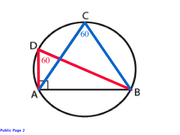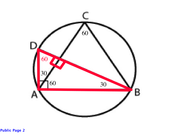Hello,
Can you please assist with the following:
In the figure, ABC is an equilateral triangle, and DAB is a right triangle. What is the area of the circumscribed circle?
(1) DA = 4
(2) Angle ABD = 30 degrees
OA: A
I was just wondering in statement 1, how we can find out if ADB is a 30 60 90 triangle?
Thanks for your help.
Regards,
Sri
Area of the circumscribed circle?
This topic has expert replies
-
gmattesttaker2
- Legendary Member
- Posts: 641
- Joined: Tue Feb 14, 2012 3:52 pm
- Thanked: 11 times
- Followed by:8 members
- GMATGuruNY
- GMAT Instructor
- Posts: 15539
- Joined: Tue May 25, 2010 12:04 pm
- Location: New York, NY
- Thanked: 13060 times
- Followed by:1906 members
- GMAT Score:790
gmattesttaker2 wrote:Hello,
Can you please assist with the following:
In the figure, ABC is an equilateral triangle, and DAB is a right triangle. What is the area of the circumscribed circle?
(1) DA = 4
(2) Angle ABD = 30 degrees
OA: A
I was just wondering in statement 1, how we can find out if ADB is a 30 60 90 triangle?
Thanks for your help.
Regards,
Sri

Since ∆ABC is equilateral, ∠ACB = 60º.
An inscribed angle is formed by TWO CHORDS.
Inscribed angles that intercept the same two points on a circle are EQUAL.
Inscribed angle ADB (in red) and inscribed angle ACB (in blue) both intercept the circle at points A and B.
Thus, ∠ADB = ∠ACB = 60º.
Since ∆ABC is equilateral, the result is the following figure:

As the figure shows, ∆ABD is a 30-60-90 triangle.
In a 30-60-90 triangle, the sides are in the following ratio:
x : x√3 : 2x.
Since AD : AB : BD = x : x√3 : 2x, diameter BD = 2(AD).
Statement 1: AD = 4
Thus, diameter BD = 2*4 = 8.
Since the diameter of the circle is known, the area of the circle can be determined.
SUFFICIENT.
Statement 2: Angle ABD = 30 degrees
No new information is offered by this statement.
The second figure above already indicates that ∠ABD = 30º.
INSUFFICIENT.
The correct answer is A.
Private tutor exclusively for the GMAT and GRE, with over 20 years of experience.
Followed here and elsewhere by over 1900 test-takers.
I have worked with students based in the US, Australia, Taiwan, China, Tajikistan, Kuwait, Saudi Arabia -- a long list of countries.
My students have been admitted to HBS, CBS, Tuck, Yale, Stern, Fuqua -- a long list of top programs.
As a tutor, I don't simply teach you how I would approach problems.
I unlock the best way for YOU to solve problems.
For more information, please email me (Mitch Hunt) at [email protected].
Student Review #1
Student Review #2
Student Review #3
Followed here and elsewhere by over 1900 test-takers.
I have worked with students based in the US, Australia, Taiwan, China, Tajikistan, Kuwait, Saudi Arabia -- a long list of countries.
My students have been admitted to HBS, CBS, Tuck, Yale, Stern, Fuqua -- a long list of top programs.
As a tutor, I don't simply teach you how I would approach problems.
I unlock the best way for YOU to solve problems.
For more information, please email me (Mitch Hunt) at [email protected].
Student Review #1
Student Review #2
Student Review #3
GMAT/MBA Expert
- ceilidh.erickson
- GMAT Instructor
- Posts: 2095
- Joined: Tue Dec 04, 2012 3:22 pm
- Thanked: 1443 times
- Followed by:247 members
Mitch's explanation is perfectly on-point. I just want to add - any time you see a SHAPE INSIDE OF ANOTHER SHAPE, it's there to show relationships.
To get the area of the circle, we need the radius, and we can infer that DB is the diameter. So clearly, if we get the length of DB, we can divide it by 2 to get the radius, and we can solve for area.
At this point, your thought should be - why the heck is that equilateral triangle there?? It seems like it has nothing to do with the area of the circle. So it must be there to tell us something about that other triangle. In this case, since angle ADB and angle ACB both hit the same points on the circle (and thus open up the same arc AB), they must have the same measurement.
Thus, we already know that triangle ADB is a 30-60-90, so all we need is a length of one of those sides, and we'll be able to infer the other two.
To get the area of the circle, we need the radius, and we can infer that DB is the diameter. So clearly, if we get the length of DB, we can divide it by 2 to get the radius, and we can solve for area.
At this point, your thought should be - why the heck is that equilateral triangle there?? It seems like it has nothing to do with the area of the circle. So it must be there to tell us something about that other triangle. In this case, since angle ADB and angle ACB both hit the same points on the circle (and thus open up the same arc AB), they must have the same measurement.
Thus, we already know that triangle ADB is a 30-60-90, so all we need is a length of one of those sides, and we'll be able to infer the other two.
Ceilidh Erickson
EdM in Mind, Brain, and Education
Harvard Graduate School of Education
EdM in Mind, Brain, and Education
Harvard Graduate School of Education



















